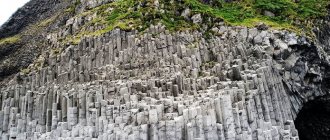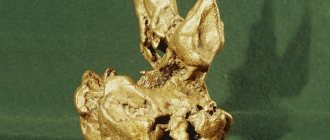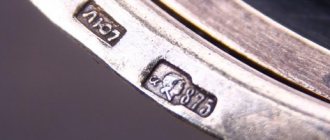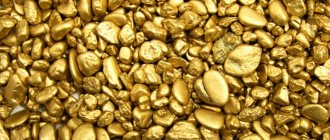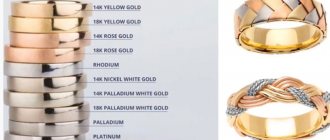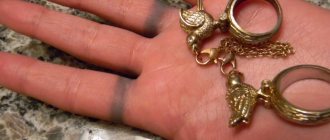Gold is an invariably sought-after symbol of wealth and luxury, an object of desire and the meaning of life for representatives of many generations.
Discovering a “gold mine” that can solve material problems in an instant is considered a rare success and the dream of almost every person. How to find gold? Finding your “piece of happiness” is almost impossible due to its inaccessibility. The location of the precious metal is known only to a few initiates, although gold is truly quite widespread in nature. Present almost everywhere (in animal and plant organisms, in water and soil), it is in such an insignificant concentration and fragmented state that its presence can be felt only through logical thinking and deep knowledge.
From the point of view of physics and chemistry, gold is a good conductor of heat and electricity, as well as a ductile metal with a high degree of malleability, capable of transforming it into a product thinner than a human hair. Everyone knows what gold jewelry looks like, as well as the fact that in the jewelry industry, high-quality products are formed in alloys with copper, silver and nickel, which give the product the necessary strength.
How gold was formed
There are several versions of the origin of gold.
One of them claims that the result was a massive fall of celestial objects containing this metal, which, having fallen inside the earth’s crust, was distributed in it and gradually penetrated to the earth’s surface due to volcanic activity.
The second version, the most common, suggests that gold was originally part of the matter that formed the Earth.
In any case, gold is formed as a result of changes occurring deep in the earth's crust at high temperatures and enormous pressure.
Areas of significant accumulation of industrially mined gold are called deposits. Gold can also be found in placers and small deposits.
Each source tells its part of the story
Gravitational waves tell physicists the size of objects and their distance, allowing them to reconstruct the moment before they collided. Observations of visible radiation and electromagnetic waves then fill in the gaps that gravitational waves cannot explain. They help astronomers discover what objects were made of and what chemical elements resulted from the collision. In our case, scientists were able to conclude that the explosion during the merger of neutron stars led to the appearance of heavy elements - gold, platinum and uranium (which was previously only assumed, but could not be confirmed by direct observation).
Now scientists have been able to see with their own eyes the alchemy of the Universe in action. “I think the impact of this discovery on science will be greater than the first detection of black holes through gravitational waves,” said Duncan Brown, another scientist from the LIGO community and Syracuse University. “There are many aspects of physics and astronomy involved.” And all this is the result of a treasure hunt among the stars, in which the whole world is involved. Race against time.
Types of deposits
According to their type, deposits, which are quite rare, are divided into 2 types: primary and secondary.
- Primary deposits
Indigenous (primary). They arise in connection with ongoing natural processes and are found mainly in mountainous areas. During volcanic activity, flows of magma containing alloys of its own compounds, minerals of the earth's crust and water erupt to the surface along faults and cracks, where they cool down after some time. This leads to their disintegration and the appearance of quartz veins containing gold. Moreover, the precious metal is presented in the form of tiny grains, invisible to the naked eye, and quantitatively depends on the conditions of formation of quartz veins and their chemical composition.
- Metals in alloys with gold
Gold is usually found in alloys with metals such as silver, platinum, copper, zinc and lead. Moreover, in the process of identifying it, an interesting relationship is visible: deposits with a significant silver content are scarce in the required gold, and vice versa: gold-bearing sources cannot boast of silver in sufficient quantities.
Some gold is mined as an accompanying metal in the development of mines containing silver, lead, copper, nickel, zinc and platinum group metals.
Primary gold deposits were formed in several ways, but were always associated with igneous rocks. The development of primary deposits for the most part occurred in the 20th century, in which the emergence of new technologies for extracting gold from ore led to an active search for gold-bearing mines. Geographically, primary deposits are most often located in the bowels of the Earth and require a mine mining method.
- Secondary deposits
Placer (secondary). Most often they are located closer to the surface, along the flow of rivers, but can be hidden under significant layers of waste rock. The formation of secondary deposits is caused by the destruction of rocks containing initial formations of gold. This process is directly influenced by factors of a physical and chemical nature: groundwater, temperature changes, precipitation, and the activity of microorganisms. Water, which plays a significant role in the movement of released gold, over time erodes rocks and carries broken pieces down, crushing them into smaller pieces during movement. Since gold is one of the heaviest metals, it, without reacting with water, can accumulate in uneven terrain formed by the terrain, at the bottom of rivers and other bodies of water, from where it is later mined.
Secondary deposits are varied (by geographical location, size and method of formation) and can be destroyed, promoting the migration of gold and the new formation of placers. Placers can occur due to changes in the natural landscape, in the event of destruction of primary deposits.
A rich placer can be formed by the accumulation of gold from several veins in one space.
Place marked with a cross
On August 17 at 8:41 a.m., LIGO detected gravitational waves—the curvature of time and space—passing through the Earth. LIGO is two observatories in the American states of Louisiana and Washington, built in the shape of the letter L. They can record waves that compress and stretch the space-time continuum.
Over the past two years, LIGO has been able to detect gravitational waves generated by the collision of black holes. But the signal on August 17 was completely different. It turned out to be much stronger than what was recorded when the black hole was discovered. The new signal lasted 100 seconds, while the signals from black holes lasted only a few. This meant that the collision occurred much closer to Earth.
When LIGO detects gravitational waves, it automatically sends notifications to hundreds of scientists around the world. Duncan Brown is one of them. “We received a phone alert very quickly and realized it was an unexpectedly strong gravitational wave signal. It shocked us,” he recalls.
It immediately became clear that this was not a merger of black holes. Initial analysis showed that the waves resulted from the collision of two neutron stars, objects with very high densities. It is believed that heavy chemical elements are formed inside them.
When LIGO detects gravitational waves from colliding black holes, it is impossible to see anything in the sky: black holes, as their name suggests, are dark. What about the collision of two neutron stars? The spectacle should resemble a colorful fireworks display.
Sarah Wilkinson / Las Campanas Observatory
And so it happened: two seconds after the LIGO signal, NASA's Fermi space telescope detected a gamma-ray burst - one of the most powerful bursts of explosive energy in the Universe known to us. For a long time, astronomers have theorized that the merger of neutron stars can cause gamma-ray bursts. And now it couldn't be a coincidence.
At the same time, the light from such an explosive merger quickly dims. The minutes were ticking, and scientists from the international LIGO scientific community were forced to hurry. “The faster you get to the telescope, the more information you get,” Brown notes. Scientists can learn a wealth of information from studying light and how it changes, helping them better understand neutron stars and how their mergers change matter.
Brown and his colleagues went into action, organizing teleconferences with dozens of scientists in all corners of the globe. The LIGO team, along with partners at VIRGO (an Italian gravitational wave observatory), worked redoubled to create a star map and determine the location of the source of the gravitational waves. They narrowed their search to an area the size of a fist within arm's reach. (In astronomical terms, even this region is a huge space. An arm's length section of the map could contain thousands of galaxies.) The VIRGO detector in Italy did not detect a signal, which helped determine the positions of the stars. VIRGO has no-reception zones, so the neutron stars must have been located near one of them.
This star map is the result of combining information received from Fermi, LIGO, VIRGO and Integral (another gamma-ray observatory). Each detector provided an area in which a signal could occur. Where they overlapped was the place marked with a cross on the map of cosmic treasures.
With the map in hand, the LIGO team sent emails to astronomers in different countries who could explore this area of the sky once night fell.
And luck did not pass them by! Several ground-based observatories have managed to detect the position of a kilonova (or macronova), an explosion from the collision of two neutron stars. On the left in the photo you can see what astronomers captured on the night of the opening. On the right is what it looked like a few days later. The explosion faded noticeably.
1M2H/UC Santa Cruz and Carnegie Observatories/Ryan Foley
This is what the galaxy looked like a couple of weeks before the kilonova formed (top image). The bottom image shows an explosion.
The Dark Energy Camera GW-EM collaboration and the DES/Berger collaboration
The images may seem blurry, but there is a wealth of information on them. With precise coordinates, scientists can tune the Hubble Space Telescope and Chandra X-ray Observatory for a kilonova explosion. With the help of these instruments, astronomers will be able to get a glimpse of the process of the universe.
What does gold look like?
Placer gold generally does not need to be extracted from solid ore, making it readily available. Therefore, efforts to discover it mostly involve searching for alluvial deposits, since the extraction of precious metal in them is much simpler and is carried out by removing a layer of waste rock covering the placer.
The discovery of large gold nuggets is considered lucky—beautiful, miraculous works of nature, which are quite rare. There are only a few dozen of them in the world, and each has its own unique name. The most substantial nugget in Russia weighing more than 36 kg was discovered in the Urals in 1842. And the champions of champions are the Australian nugget from 1869, weighing 70.9 kg with a gold content of 69.6 kg, and a huge block called the “Holtermann Plate”, weighing 235.14 kg with 82.11 kg of pure gold in it, found in 1871.
What most of the remaining nuggets look like is unknown to history, since many of the ingots were subjected to melting, a process that is disastrous for such works of art.
Major historical events in the development of gold
History has many significant events in the development of gold. It has come a long way from ancient times to our time.
The table reflects a brief chronology of the world’s “golden” history:
| 1500 BC e. | Gold debuted as a recognized standard of exchange in international trade. |
| 50 BC e. | The ancient Romans first issued a gold coin. |
| 1066 AD e. | The Norman conquerors firmly established the British monetary system. |
| 1284 n. e. | England issued the gold florin, the country's first major gold currency. |
| 1900 AD e. | The United States officially went on the gold standard. |
| 1971 e. | President Nixon ended the gold standard in America. |
| 1978 e. | There is increasing interest in buying bullion to store value and hedge against inflation. |
| 2011 e. | The price of gold reached a record high of $1,923 per ounce. |
Over the past 50 centuries, national currencies have undergone many changes, coming and going. But this precious metal remains a valuable resource to this day and is not going to lose its position in the near future.
Digital statistics of gold mining
History has recorded the richest accumulations of ore and placer gold containing 100 grams or more of precious metal per ton of rock. Small areas were marked with kilogram gold grades per tonne of ore.
Modern mines are considered rich if there are more than 10 grams of gold per 1000 kg of ore, and a profitable rate is 4-5 grams per thousand kilograms. Profitability and material justification, in addition to the specific gravity of gold in the rock, are determined by such indicators as the depth of ore veins, the nature of the rock, transport conditions, and development of the territory.
By the way, the first discoveries of the precious metal were in alluvial deposits: People discovered small nuggets in river beds and on the banks of streams. Gold rushes in Alaska, Australia and California are associated with placers; in the 19th century, such deposits accounted for 90% of the world's gold. This figure fell steadily throughout the 20th century, reaching 2% in 1971. Recently, the percentage has increased slightly due to the revival of gold mining in old (even abandoned) mines and new locations. This is especially true for Colombia, Brazil and a number of other countries.
If we consider natural gold reserves by country, the United States takes 1st place, with 59 deposits with gold reserves of more than 13 thousand tons; followed by Canada and South Africa with similar indicators; Russia ranks 4th with gold production of more than 9 thousand tons from 33 deposits.
Gold, description, characteristics, interesting and useful facts
Gold is the most famous and popular precious metal in the world. Gold is a chemical element. Its chemical symbol is Au and its atomic number is 79. Compared to other metals, gold is less chemically reactive. Gold is a good conductor of electricity and heat.
Gold is shiny, soft and dense. It is also malleable, meaning it can be easily broken into thin sheets or other shapes. Gold is malleable enough that it can be hammered as little as one gram into a sheet measuring 1 square meter. It can also be made so thin that it appears transparent.
Due to its resemblance to gold, the mineral pyrite is nicknamed fool's gold. The amount of gold in various alloys (a combination of gold and another metal such as silver) is measured in carats (k). Pure gold 24k. As of 2009, it is estimated that humans have mined about 160,000 tons of gold throughout the history of the world.
Over the past 100 years, South Africa has been the largest producer of gold. However, it has recently surpassed China. As of 2009, the US has 8,133 tons of gold reserves, while Canada has only 3. Throughout history, gold has often been seen as a symbol of wealth.
Similar articles
How to melt silver to make jewelry
How to distinguish gold from fakes at home: features, recommendations
Gold leaf, characteristics and description, questions
Gold is the most popular precious metal for investment. The price of gold fluctuates constantly and is often linked to major economic events. There is a monetary system called the “gold standard”, which pegs the currency unit to a specific weight of gold.
Over the years, gold has been used to create expensive jewelry, coins, and various forms of art, such as the famous funerary mask of the Egyptian pharaoh Tutankhamun. Nowadays it is also used for things like electronics and dentistry.
Injectable gold has been shown to help reduce pain and swelling in patients suffering from tuberculosis and rheumatoid arthritis. Gold is a popular choice when it comes to rewarding achievements with medals, statues and trophies. All Oscar, Olympic and Nobel laureates receive gold items in recognition of their achievements.
- The term "gold" comes from the Proto-Indo-European base *ghel/*ghol, meaning "yellow", "green" or possibly "bright"
- Gold has been discovered on every continent on earth.
- Gold melts at 1064.43°C. It can conduct both heat and electricity and never rusts.
- Medical research in France in the early twentieth century found gold to be an effective treatment for rheumatoid arthritis.
- Due to its high value, most gold discovered throughout history is still in circulation. However, it is believed that 80% of the world's gold is still in the ground.
- Seventy-five percent of all gold in circulation has been mined since 1910.
- The largest gold nugget ever found is the "Welcome Stranger", discovered by John Dizon and Richard Oates in Australia on February 5, 1869. The nugget measured 10 by 25 inches and yielded 2,248 ounces of pure gold. It was found just two inches below the surface of the ground.
Gold threads can even be used as embroidery
- Gold is so malleable that it can be turned into sewing thread. An ounce of gold can be stretched 50 miles.
- Amid fears of a recession, in March 2008 the price of gold exceeded $1,000 an ounce for the first time in history.
- Traditionally, investors try to preserve their assets during difficult economic times by investing in precious metals such as gold and silver. The World Gold Council released a report in February 2009 which indicated that gold demand had risen sharply in the second half of 2008.
- The Dow/Gold ratio, which shows how much gold it would take to buy one share of the Dow, is a good indicator of how severe the recession is. In early 2009, the Dow/Gold ratio appeared to be approaching the same low ratios that occurred in the 1930s and 1980s.
- Gold is chemically inert, which also explains why it never rusts or causes skin irritation. If gold jewelry irritates your skin, it is likely that the gold was mixed with some other metal.
- One cubic foot of gold weighs half a ton. The world's largest gold bar weighs 200 kg (440 lb).
- In 2005, Rick Munarriz asked the question of whether Google or gold is a better investment when both appear to have equal value in the stock market. By the end of 2008, Google closed at $307.65 per share and gold closed the year at $866 per ounce.
- The Olympic gold medals awarded in 1912 were made entirely of gold. Currently, gold medals simply have to be plated with six grams of gold.
- The Incas believed that gold represented the glory of their sun god and called the precious metal "tears of the sun." Since gold was not yet used for money, the Incas' love for gold was purely aesthetic and religious.
There is enough gold in the Earth's core to cover the planet's surface to a depth of 12 to 13 feet.
- Gold is so rare that the world pours out more steel in an hour than gold since the beginning of history.
- Around 1200 BC The Egyptians used sheep skins to extract gold dust from the sands of the Black Sea. This practice is most likely the inspiration for The Golden Fleece.
- The Turin Papyrus shows the first map of a gold mine in Nubia, the largest gold producer in antiquity. Indeed, the Egyptian word for gold was "nub" from gold-rich Nubia. While Egyptian slaves often suffered horribly in the gold mines, Egyptian artisans who made gold jewelry for the nobility enjoyed a high, almost priestly status.
- Although the ancient Hebrews apparently had enough gold to create and dance around the golden calf while Moses talked to God on the mountain. Sinai, scholars suggest that it never occurred to the Jews to bribe themselves out of captivity because gold was not yet associated with money.
- The Bible contains over 400 references to gold, including God's specific instructions to cover the furniture of the tabernacle with “pure gold.” Gold is also mentioned as one of the gifts of the Magi.
- The Greeks thought that gold was a dense combination of water and sunlight.
- Carat weights can be 10, 12, 14, 18, 22 or 24. The higher the number, the higher the purity. To be called "fine gold", gold must weigh at least 10 carats. "Pure gold" should be 24 carats (although it still has a small amount of copper). Pure gold is so soft that it can be sculpted by hand.
Pure gold, the 24-karat variety, is too soft to be used for quality jewelry.
- In 560 BC. the Lydians introduced the first gold coin, which was actually a natural amalgam of gold and silver called electrum. Herodotus criticizes the materialism of the Lydians, who were also the first to open permanent retail stores. When the Lydians were captured by the Persians in 546 BC, the use of gold coins began to spread.
- Before gold coins were used as money, various types of livestock, especially cattle, and plant products were used as currency. Additionally, large government construction projects were completed with slave labor due to the limited range of uses for money.
- When honking geese warned the Romans that the Gauls were about to attack the temple where the Romans kept their treasure, the grateful Roman citizens built a temple to Moneta, the goddess of warning. The connection between the rescued treasure and the Coin led many centuries later to the English words "money" and "mint".
- Between 307 and 324 AD, the value of one pound of gold in Rome rose from 100,000 denarii (Roman coin) to 300,000 denarii. By the mid-fourth century, a pound of gold was worth 2,120,000,000 denarii—an early example of runaway inflation, partly responsible for the collapse of the Roman Empire.
Gold, a noble metal, was named after Aurora, the goddess of the dawn.
- The chemical symbol for gold is Au, from the Latin word aurum, meaning "blazing dawn", and from Aurora, the Roman goddess of the dawn. In 50 BC, the Romans began issuing gold coins called Aureus and the lesser solidus.
- The Pyx test (a public test of the quality of gold) began in England in 1282 and continues to this day. The term "pyx" refers to the Greek boxwood that houses the coins that will be presented to the jury for testing. The coins are currently being tested for diameter, chemical composition and weight.
- During the fourteenth century, drinking molten gold and crushed emeralds was used as a treatment for the bubonic board.
- In 1511, King Ferdinand of Spain coined the immortal phrase: “Get gold, if possible, humanely, but in all dangers, get gold.”
- In 1599, the Spanish governor in Ecuador taxed the Jivaro tribe so heavily that they executed him by pouring molten gold down his throat. This form of execution was also practiced by the Romans and the Spanish Inquisition.
- Venice introduced the gold ducat in 1284, and over the next 500 years it became the most popular gold coin in the world. Ducat means "duke" in Latin. This is the currency used in Shakespeare's Romeo and Juliet and mentioned in The Merchant of Venice. In his song "I'm Not the One," rapper Ice Cube sings that "he's getting juice for his ducats." Dukat is also used in the science fiction series Babylon 5 as the name for the money of the Centauri race.
- The United States Mint originally produced fine gold coins in values of $2.50, $10, and $15. Gold minting ceased in 1933 during the Great Depression.
- Gold is edible. Some Asian countries are investing gold in fruits, gummy snacks, coffee and tea. Since at least the 1500s, Europeans have included gold leaf in liquor bottles such as Danziger Goldwasser and Goldschlager. Some Native American tribes believed that consuming gold could allow people to levitate.
While gold is actually tasteless, it can add a lot of sparkle to a menu.
- The San Francisco 49ers are named after the miners of the 1849 Gold Rush.
- Gold and copper were the first metals discovered by humans around 5000 BC, and are the only two metals that are not white.
- The value of gold has been used as a standard for many currencies. After World War II, the United States created the Bretton Woods system, in which the value of the US dollar was 1/35 of a troy ounce (888.671 mg) of gold. This system was abandoned in 1971 when there was no longer enough gold to cover all the paper money in circulation.
- The world's largest gold reserve is located in a five-story underground vault inside the Federal Reserve Bank of New York vault and houses 25% of the world's gold supply (540,000 gold bars). Although it contains more gold than Fort Knox, most of it is owned by foreign governments.
- The “troy ounce” of gold comes from the French city of Troyes, which was the first to create a system of weights for precious metals and precious stones in the Middle Ages. One troy ounce is 480 grains. The grain is exactly 64.79892 mg.
The word "alchemy" is borrowed from the Arabic word al-kīmiyā
, which means "philosopher's stone".
- Both Greeks and Jews begin to practice alchemy in 300 BC. The quest to convert base metals into gold would reach its zenith during the late Middle Ages and the Renaissance.
- The gold standard was replaced by most governments with the fiat standard (Latin for “let it be done”). Both Thomas Jefferson and Andrew Jackson strongly opposed fiat currency. Some modern economists argue that fiat currency increases the speed of boom and bust cycles and causes inflation.
- South Africa's mines can go down to 12,000 feet and reach temperatures of 130°F. Producing an ounce of gold requires 38 man-hours, 1,400 gallons of water, enough electricity to run a large house for ten days, and chemicals such as cyanide, acids, lead, borax and lime. To produce 500 tonnes of gold per year in South Africa, approximately 70 million tonnes of earth are mined and ground.
- Only about 142,000 tons of gold have been mined throughout history. Assuming a gold price of $1,000 per ounce, the total amount of gold mined would be approximately $4.5 trillion. The United States alone circulates or invests more than $7.6 trillion, indicating that a return to the gold standard is impossible. Although most scholars agree that a return to the gold standard is impossible, some gold standard proponents (such as many libertarians and objectivists) argue that a return to the gold standard system would ease inflationary risks and limit government power.
- The first recorded gold ever discovered in the United States was a 17-pound nugget found in Cabarrus, North Carolina. When more gold was discovered in Little Meadow Creek, North Carolina, in 1803, the first gold rush in the United States began.
- In 1848, while building a sawmill for John Sutter near Sacramento, California, John Marshall discovered gold flakes. This discovery sparked the California Gold Rush and accelerated the settlement of the American West.
The Sun God Ra was often referred to as the golden mountain.
- In ancient Egypt, gold was considered the skin or flesh of the gods, especially the Egyptian sun god Ra. Consequently, gold was unavailable to anyone except the pharaohs, and only later to priests and other members of the royal court. The chambers that contained the royal sarcophagus were known as the "golden house".
- In 1933, Franklin Roosevelt signed Executive Order 6102, which prohibited US citizens from hoarding gold. Possession of gold (excluding jewelers, dentists, electricians and other industry workers) was punishable by a fine of up to $10,000 and/or ten years in prison.
- Tiny spheres of gold are being used by the Amersham Corporation in Illinois as a way to tag specific proteins to determine their function in the human body to treat disease.
- The purity of gold is measured in carat weight. The term "carat" comes from "carob seed", which was standard for weighing small quantities in the Middle East. Carats were the fruit of the carob bean tree, each pod weighing 1/5 of a gram (200 mg).
Interesting facts about gold
- Gold is the only metal that is yellow or “golden.” Other metals may turn yellowish, but only after they have oxidized or reacted with other chemicals.
- Almost all of the gold on Earth came from meteorites that bombarded the planet within 200 million years of its formation.
- The element symbol for gold is Au. The symbol comes from the old Latin name for gold, aurum, meaning "radiant dawn" or "sunrise radiance". The word gold comes from Germanic languages, deriving from Proto-Germanic gulþ and Proto-Indo-European ghel, meaning "yellow/green." The pure element has been known since ancient times.
- Gold is extremely malleable. One ounce of gold (about 28 grams) can be stretched into a gold thread 5 miles (8 kilometers) long. Gold threads can even be used as embroidery.
- Malleability is a measure of how easily a material can be hammered into thin sheets. Gold is the most malleable element. One ounce of gold can be stamped onto a sheet that is 300 square feet. The gold leaf can be made thin enough to be transparent. Very thin sheets of gold can appear greenish-blue because gold is highly reflective of red and yellow.
- Although gold is a heavy, dense metal, it is generally considered non-toxic. The golden metallic flakes can be consumed in food or drink.
- Pure elemental gold is 24 karat, while 18 karat gold is 75% pure gold, 14 karat gold is 58.5% pure gold, and 10 karat gold is 41.7% pure gold. The remainder of the metal commonly used in gold jewelry and items is silver, but items may also be composed of other metals or combinations of metals such as platinum, copper, palladium, zinc, nickel, iron, and cadmium.
- Gold is a noble metal. It is relatively non-reactive and resistant to degradation by air, moisture or acid. While acids will dissolve most metals, a special mixture of acids called aqua regia is used to dissolve gold.
- Gold has many uses beyond its monetary and symbolic value. Among other applications, it is used in electronics, electrical wiring, dentistry, electronics, medicine, radiation protection, and glass coloring.
- High purity metallic gold is odorless and tasteless. This makes sense since the metal does not react. Metal ions are what give metallic elements and compounds their taste and smell.
Gold is one of 92 natural elements found on earth. There is no known natural substance that can destroy gold. It can be dissolved chemically, but even then it remains as gold - just in a more widely dispersed state.
For centuries, people have been thinking about where gold could come from, that is, about its native source. Scientists have recently discovered that gold can be produced artificially by atomic bombing with lead, which is another basic element. However, the process is very expensive, more than the value of the resulting gold. Therefore, gold is not produced artificially on a commercial scale. However, this discovery has led to the theory that the gold found on our earth may have originally been produced in the nuclear Furnaces of stars that have long since disappeared, our planet being part of the remaining debris.
The scientific symbol for gold is Au. This is number 79 on the periodic table of elements. Gold is not magnetic, but it is an excellent conductor of electricity. Its melting point is 1945° F. Gold does not corrode or tarnish when exposed to moisture, does not oxidize (rust) when exposed to oxygen and water, and is not affected by common acids like most other metals. Deposits of gold lying inside a mountain, or under a stream bed, or even at the bottom of the ocean, will remain there and will not be touched until the natural forces of the earth are taken over by man.
Gold is a very soft metal, a 2.3 on the hardness scale of 10, which is one of the factors that gives gold its enormous malleability—meaning it can be pounded, twisted, rolled and/or squeezed into all sorts of different shapes without breaking . In fact, the yellow metal can be driven so thin that it is translucent, and still remain intact as a solid piece of gold. It is said that such gold sheets can be so thin that it would take a quarter of a million sheets stacked on top of each other to form a stack just one inch high!
Thin sheets of gold such as these have the distinctive quality of transmitting sunlight, but they will reflect most of the sun's infrared rays (heat). For this reason, thin layers of gold are now used in the window glass found in many modern skyscrapers to help save on the enormous energy costs required to keep the interior of such buildings cool during the hot summer months.
Similar films of gold were also used in the face shields of helmets used by astronauts to reflect much of the increasing bombardment by infrared rays that occurs in space.
Watch what happens to gold when it is hammered in the following video sequence. It is for this reason that most gold found at the bottom of the waterway is crushed and smooth.
Gold is extremely ductile, meaning it can be drawn into wire or thread forms without becoming brittle or brittle. It is said that gold can be drawn so thin that one ounce can be drawn to stretch a continuous length of 35 miles. This would indeed make the filament very thin, but that's exactly what is needed in the modern electronics industry, where entire circuits are packed into chips the size of a pinhead.
Due to its high electrical conductivity, exceptional wear resistance and ductile properties, gold is in high demand in the electronics industry. Therefore, it is not uncommon to find gold used in the circuitry of many modern electronic devices, such as modern televisions and calculators, not to mention some of the most advanced electronic devices in the world today.
Gold is also widely used by dentists and is widely used in jewelry. Over the past few years, the use of gold in coin production has increased significantly. Gold has another distinguishing quality that is perhaps most important to the explorer (other than its cost), and that is its weight. Gold is extremely dense, one of the heaviest metals. The specific gravity of gold is 19.6, which means it weighs 19.6 times more than an equal volume or mass of pure water.
Iridium (one of the platinum group metals) is one of the few metals that has a higher specific gravity than gold, at 22.6. Gold is approximately 8 times heavier than the quartz rock with which it is commonly associated when gold is in solid form.
One cubic foot of gold would weigh approximately 1,187 pounds. It is this quality of gold, having a superior weight factor compared to other materials commonly found with it, that is used in most gold extraction methods.
Gold is not the most valuable metal, but it is extremely valuable and probably the most sought after of all the valuable metals found on earth. At today's market value, the same cubic foot of pure gold would be worth about $10 million. A cubic inch of pure gold would cost about $7,000. So gold is valuable, very valuable indeed; and it is not very much to accumulate a significant amount of wealth.
There is another distinctive quality of gold that is worthy of mention. In its natural form, gold is a very rich and beautiful substance to look at. In fact, this is so true that there is a saying among experienced miners and those who deal with a lot of the yellow metal that it is not a good idea to look too long at any significant amount of raw gold in any given period of time.
This is because it tends to cause a condition called "gold rush". This is true!
The Gold Rush affects different people differently. While this may make one person want to buy gold at almost any price, it can just as easily make another want to steal it - at any price. However, "fever" always makes a person want to have gold for himself or more if possible to get it depending on the character of the person. This condition (gold rush) is something that anyone planning to mine or deal with gold should pay attention to. There is nothing to laugh about because it has caused many deaths, failures, wars, enslavement and loss of friendships.
It changed the course of a significant amount of history - much of it worse for others involved. It's true that for many, gold is what dreams are made of. Thus, gold tends to go beyond social behavior in a person and bring out some of the strong passions that lie underneath. It's good to keep this in mind as you consider who to take on as a partner (or employee) in a gold mining operation of any size. One common characteristic of a person who has been slightly touched by a gold rush incident is that he or she is apt to abandon common sense in business and dive in head over heels, as a small child might do if he or she found a bathtub full of his or her favorite candy or ice cream.
This is the very factor from which the scammer gets excited and acts out. And if you think there aren't many experienced in the gold mining field, think again. Most failures in gold mining are the result of the same loss of common sense that sometimes occurs when working with valuable metals. Perhaps the most successful precaution against being "harmed" by a "fever" is the honest acceptance of the view that "everything worthwhile costs a lot of time and effort."
It is people who intend to get rich quickly without much energy on their part who most often fail in the gold mining business. If, after examining your own intentions, you find that you are interested in getting rich quick without having to resort to it, it is almost certain that you have caught at least a touch of the fever. On the other hand, if you are interested in going to God's own country to see if you can find a piece of yellow metal as an adventure and/or perhaps to see if it can be done as a viable business venture, you are probably on the right track and you have a better chance of success. And who knows, maybe you'll land a big hit; that happens!
Just remember that finding and mining gold is like any other business venture. It takes a lot of time and work to consistently achieve success.
How deposits are developed
Finding gold is very difficult; its extraction is an art. There are no special indicators that can accurately determine its presence in rocks. Therefore, when searching for gold, a thorough study of the area, a deep understanding of geology, observation, accumulated experience, knowledge of modern exploration methods and, of course, intuition are required.
Along with the exploration of mineral territories, special attention must be paid to the percentage of gold in the total mass of ore in order to understand the economic efficiency of the developed deposit. Profitability will be fully justified if its satellites, other minerals, are mined with gold.
Assessing the world's current gold reserves requires a global approach. This means taking various rock samples, carrying out repeated calculations regarding the profitability of gold mining, and performing drilling and geological exploration work on a significant scale.
Here is an example of preparing a field for production:
- primary reconnaissance, covering the search and assessment of lands, as well as establishing the order of their transfer in subsequent preparatory phases;
- target survey to delineate the mine boundaries;
- preliminary engineering work;
- taking metallurgical samples;
- carrying out economic calculations and methods of probable analysis;
- rental or acquisition of land plots with fossil gold;
- preparatory work for the transfer of the deposit to industrial development using complex, state-of-the-art equipment.
Upon completion of exploration and preparation of the deposit for industrial work, the construction of a gold mining enterprise begins. The construction of a modern gold mine can cost half a million dollars, taking into account capital costs and the number of employees, the number of which ranges from 15-20 thousand people.
The annual gross output of the newly formed enterprise is approximately 40 tons of metal, which in monetary terms is equivalent to 500 million dollars.
What is white gold made of?
White gold is composed primarily of gold and a mixture of dense metals such as copper, zinc, nickel, rhodium or palladium. The white color is achieved by carefully selecting alloying metals that bleach the reddish-yellow color of pure gold.
The amount of gold is measured in a unit called karats (K). In 24 karat gold, all 24 parts of gold are pure gold with extremely low levels of impurities.
Similarly, 18k gold contains 75% (or 18/24) gold, while 22k gold is 91.6%.
The proportion of alloy added affects the overall durability and final color of the gold. For example, 22 karat gold is stronger and has a more yellowish tint than 18 karat gold.
As a rule, white gold is marked as 18 carats. It contains 75% gold and approximately 25% nickel and zinc. Some types of white gold contain 90% gold and 9.5% nickel. To increase ductility, a small amount of copper is added to it.
White gold used in the jewelry industry is an alloy of gold-nickel-copper-zinc or gold-palladium-silver. Nickel and palladium act as primary bleaching agents to reduce the color of gold, and zinc acts as a secondary bleaching agent for copper.
Why is gold alloyed with other metals?
Because pure gold is a very soft and malleable metal, it is alloyed with a mixture of metals to increase strength and durability for use in jewelry. In fact, the gold you see in any industry is rarely pure. Some impurities (such as mercury) are added before alloying to produce white gold. Without harder alloys, pure gold would not be able to maintain its desired shape—gold itself would be too soft.
18k white gold chain
Some white gold jewelry is additionally plated with rhodium, a rare silvery-white metal. It enhances the shine and durability of jewelry, giving it smoothness and shine.
Other types of colored gold
Pure gold is a soft, slightly reddish-yellow metal. However, when alloyed with harder metals, it produces a range of colors including yellow, red, green, purple, blue and black.
Yellow Gold: Has a unique warm glow. It is considered more traditional than white gold. Unlike white gold and platinum, which look the same, yellow gold is difficult to imitate.
It is usually alloyed with copper and silver. Most 18k yellow gold items contain 75% gold, 12.5% copper and 12.5% silver. A darker yellow color is achieved by increasing the amount of copper to 15%.
Rose Gold and Red Gold: Seem similar, but the difference lies in the copper content. The higher the concentration of copper in the alloy, the darker the red color. Red gold contains the most copper, while rose gold contains the least. Sometimes zinc is added to the alloy to give it a reddish-yellow color.
18K rose gold contains 75% gold, 20% copper and 5% silver; 18K rose gold has the same amount of gold with 22% copper, 4% silver; and 18K red gold contains 25% copper and no silver. 12K red gold contains gold and copper in equal proportions.
Blue gold: is an intermetallic compound obtained by mixing gold with indium or gallium. The first contains 54% indium and 46% gold, and the second contains 59% gold and 41% gallium.
Purple Gold: is an alloy of gold (79%) and aluminum (21%). These intermetallic compounds are quite rare and more brittle than most gold alloys.
Black gold: obtained through various surface treatment methods. Gold alloys with a high copper content can be dyed a variety of colors from black to brown by treating them with potassium sulfide.
Black gold can also be produced by controlled oxidation of gold alloys containing cobalt or chromium, or by creating nanostructures on the surface using a femtosecond laser.
Gray Gold: Typically produced by mixing gold (75-76%) with palladium (15-23%) and rhodium (1-5%). 18K gray gold can also be produced without bleaching elements such as palladium, nickel and cobalt - this inexpensive alternative includes 75-78% gold, 7-15% manganese, 1-10% silver and 1-2% copper.
Green Gold: Made by adding 4% cadmium. Its use is generally reduced because cadmium is toxic.
